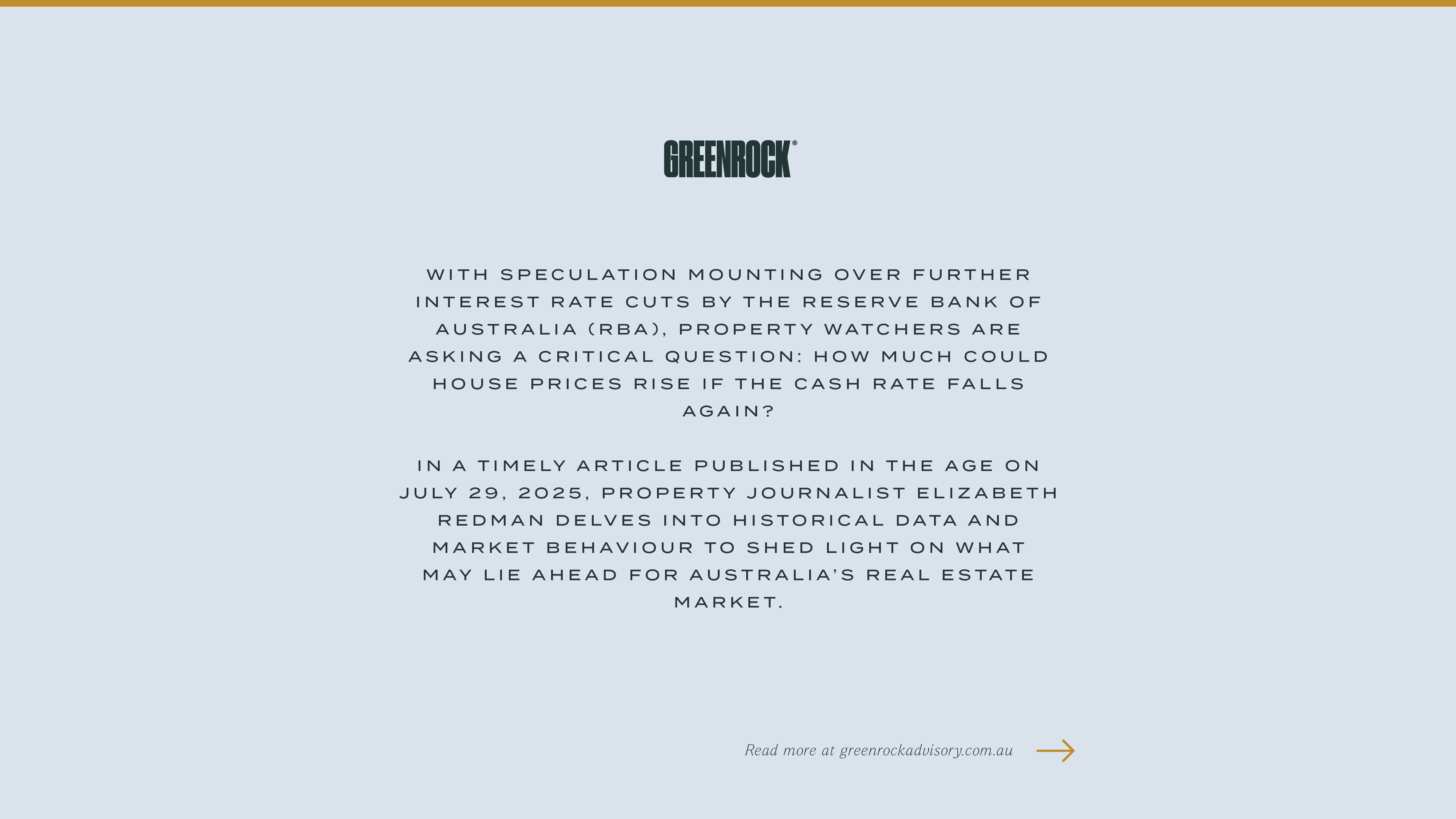FEATURED INSIGHTS
Our professional ecosystem streamlines your JOURNEY BY partnering with industry leaders.
With speculation mounting over further interest rate cuts by the Reserve Bank of Australia (RBA), property watchers are asking a critical question: how much could house prices rise if the cash rate falls again? In a timely article published in The Age on July 29, 2025, property journalist Elizabeth Redman delves into historical data and market behaviour to shed light on what may lie ahead for Australia’s real estate market.

Based on reporting by Elizabeth Redman, The Age
Rate Cuts as a Catalyst for Property Growth
Redman’s article draws heavily on data from CoreLogic, revealing that on average, national dwelling values have increased by approximately 6.1% for every one percentage point reduction in the RBA cash rate. This strong correlation underscores how sensitive Australian property markets are to changes in borrowing conditions.
Crucially, the impact isn’t evenly distributed. Premium inner-city suburbs in Sydney and Melbourne have historically shown far more dramatic price growth than regional or lower-cost areas. In fact, in suburbs like Leichhardt, price increases of up to 19% have been observed in response to a single 1% rate cut, more than triple the national average.
Which Markets React the Fastest?
Redman’s analysis highlights that Sydney and Melbourne remain the most responsive to rate cuts, especially in affluent or high-demand districts. These areas often see sharp rises in buyer competition when borrowing becomes cheaper, leading to rapid price acceleration.
By contrast, Brisbane, Adelaide, and Perth, though still affected, tend to show a more subdued reaction. These markets are driven more by local economic conditions, such as employment trends and migration, than by interest rates alone.
The February 2025 Rate Cut: A Real-Time Case Study
Redman references the RBA’s February 2025 cash rate cut—the first reduction in years, from 4.10% to 3.85%, as a recent example. According to CoreLogic figures, national dwelling values rose 0.4% in March, shortly after the cut. This gain was modest but consistent with prior early-cycle movements.
In the same month:
• Sydney values rose by around 0.3%
• Melbourne saw a slightly stronger lift of 0.5%
These figures support the view that while price growth isn’t immediate or uniform, interest rate reductions typically set the stage for upward momentum, especially in larger capital cities.
Historical Patterns Suggest More Growth Ahead
Redman notes that if future rate cuts amount to a full 1% over time, Australia could see an average national price increase of around 6%, with elite suburbs likely posting double-digit growth.
This potential upswing is embedded in historical precedent, but also contingent on several factors:
• Housing supply constraints continue to limit stock.
• Affordability challenges may moderate buyer demand in outer suburbs.
• The rising cost of living could blunt the impact of cheaper borrowing.
Nonetheless, the real estate market remains tightly linked to monetary policy, and the potential for substantial price growth remains, especially if more cuts follow in 2025–26.
Important Caveats to Consider
Redman wisely includes several caveats. She points out that:
• Not all markets benefit equally regional and lower-cost areas are less rate-sensitive.
• Supply dynamics, investor sentiment, and affordability all temper the effect of rate cuts.
• Practices like underquoting are again surfacing, as agents respond to increasing buyer competition in high-demand areas.
These factors mean that while the historical pattern is clear, current conditions may produce more subtle outcomes.
Conclusion: Redman’s Timely Warning and Insight
Elizabeth Redman’s piece is a valuable resource for understanding the likely effects of interest rate reductions on property prices in Australia. Her use of CoreLogic data, combined with insights into market-specific behaviour, provides a grounded look at how different sectors of the housing market respond when borrowing becomes cheaper.
The takeaway? If the RBA continues to ease monetary policy, property prices are poised to climb - but not evenly. For prospective buyers and investors, the implications are clear: know your market, monitor rates closely, and prepare for increased competition in Australia’s most in-demand suburbs.
Reference: Australia property: How far property prices rose last time interest rates fell
Our professional ecosystem streamlines your JOURNEY BY partnering with industry leaders.

The Year To Invest - Are You Ready For 2025
14/1/25
Now is the perfect time to plan your next move

Commercial property Investing
1/8/24
Have you been considering investing in Commercial Property?

Addressing Australia's Housing Crisis through Sustainability and the Circular Economy
18/6/24
Copyright © 2023, All Rights Reserved. DESIGNED & Developed By ACMEmedia.com | Studionascent.com